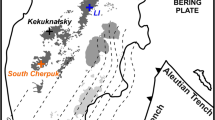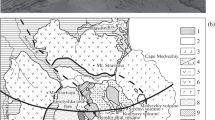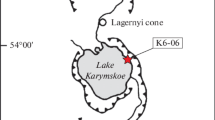Abstract
The paper presents data on naturally quenched melt inclusions in olivine (Fo 69–84) from Late Pleistocene pyroclastic rocks of Zhupanovsky volcano in the frontal zone of the Eastern Volcanic Belt of Kamchatka. The composition of the melt inclusions provides insight into the latest crystallization stages (∼70% crystallization) of the parental melt (∼46.4 wt % SiO2, ∼2.5 wt % H2O, ∼0.3 wt % S), which proceeded at decompression and started at a depth of approximately 10 km from the surface. The crystallization temperature was estimated at 1100 ± 20°C at an oxygen fugacity of ΔFMQ = 0.9–1.7. The melts evolved due to the simultaneous crystallization of olivine, plagioclase, pyroxene, chromite, and magnetite (Ol: Pl: Cpx: (Crt-Mt) ∼ 13: 54: 24: 4) along the tholeiite evolutionary trend and became progressively enriched in FeO, SiO2, Na2O, and K2O and depleted in MgO, CaO, and Al2O3. Melt crystallization was associated with the segregation of fluid rich in S-bearing compounds and, to a lesser extent, in H2O and Cl. The primary melt of Zhupanovsky volcano (whose composition was estimated from data on the most primitive melt inclusions) had a composition of low-Si (∼45 wt % SiO2) picrobasalt (∼14 wt % MgO), as is typical of parental melts in Kamchatka and other island arcs, and was different from MORB. This primary melt could be derived by ∼8% melting of mantle peridotite of composition close to the MORB source, under pressures of 1.5 ± 0.2 GPa and temperatures 20–30°C lower than the solidus temperature of “dry” peridotite (1230–1240°C). Melting was induced by the interaction of the hot peridotite with a hydrous component that was brought to the mantle from the subducted slab and was also responsible for the enrichment of the Zhupanovsky magmas in LREE, LILE, B, Cl, Th, U, and Pb. The hydrous component in the magma source of Zhupanovsky volcano was produced by the partial slab melting under water-saturated conditions at temperatures of 760–810°C and pressures of ∼3.5 GPa. As the depth of the subducted slab beneath Kamchatkan volcanoes varies from 100 to 125 km, the composition of the hydrous component drastically changes from relatively low-temperature H2O-rich fluid to higher temperature H2O-bearing melt. The geothermal gradient at the surface of the slab within the depth range of 100–125 km beneath Kamchatka was estimated at 4°C/km.
Similar content being viewed by others
References
J. B. Gill, Orogenic Andesites and Plate Tectonics (Springer-Verlag, Berlin-Heidelberg, 1981.
T. Plank, “Constraints from Thorium/Lanthanum on Sediment Recycling at Subduction Zones and the Evolution of the Continents,” J. Petrol. 46, 921–944 (2005).
S. M. Peacock, T. Rushmer, and A. B. Thompson, “Partial Melting of Subducting Oceanic Crust,” Earth Planet. Sci. Lett. 121(1–2), 227–244 (1994).
P. E. van Keken, B. Kiefer, and S. M. Peacock, “High-Resolution Models of Subduction Zones: Implications for Mineral Dehydration Reactions and the Transport of Water into the Deep Mantle,” Geochem. Geophys. Geosyst 3 (2002). Doi:10.1029/2001GC000256.
V. C. Manea, M. Manea, V. Kostoglodov, and G. Sewell, “Thermal Models, Magma Transport and Velocity Anomaly Estimation beneath Southern Kamchatka (Chapter 31),” in Plates, Plumes, and Paradigms, Ed. by G. R. Foulger, D. L. Anderson, J. H. Natland, and D. C. Presnall, Geol. Soc. Am. Sp. Pap. London 388, 388–431 (2005).
A. V. Sobolev and M. Chaussidon, “H2O Concentrations in Primary Melts from Island Arcs and Mid-Ocean Ridges: Implications for H2O Storage and Recycling in the Mantle,” Earth Planet. Sci. Lett. 137, 45–55 (1996).
V. B. Naumov, M. L. Tolstykh, E. N. Grib, et al., “Chemical Composition, Volatile Components, and Trace Elements in Melts of the Karymskii Volcanic Center, Kamchatka, and Golovnina Volcano, Kunashir Island: Evidence from Inclusions in Minerals,” Petrologiya 15(6), 563–581 (2007) [Petrology 16, 1–18 (2008)].
V. I. Kovalenko, V. B. Naumov, M. L. Tolstykh, et al., “Composition and Sources of Magmas in Medvezh’ya Caldera (Iturup Island, Southern Kuriles) from a Study of Melt Inclusions,” Geokhimiya 2004 (5), 467–487 (2004) [Geochem. Int. 42, 393–413 (2004)].
J. Blundy, K. Cashman, and M. Humphrys, “Magma Heating by Decompression-Driven Crystallization beneath Andesite Volcanoes,” Nature 443, 76–80 (2006).
M. V. Portnyagin, K. Hoernle, P. Y. Plechov, et al., “Constraints on Mantle Melting and Composition and Nature of Slab Components in Volcanic Arcs from Volatiles (H2O, S, Cl, F) and Trace Elements in Melt Inclusions from the Kamchatka Arc,” Earth Planet. Sci. Lett. 255(1–2), 53–69 (2007).
T. Plank, L. Cooper, and C. E. Manning, “Emerging Geothermometers for Estimating Slab Surface Temperatures,” Nature GeoScience 2, 611–615 (2009).
Yu. P. Masurenkov, I. V. Florenskii, and I. V. Melekestsev, “Zhupanovsky Volcano,” in Active Volcanoes of Kamchatka (Moscow, Nauka, 1991), pp. 216–225 [in Russian].
L.I. Bazanova, O.V. Dirksen, R. V. Kulish, and E. V. Kartashova, “Evolution of the Youngest Volcanism of the Zhupanov Range, Kamchatka,” in Volcanism and Geodynamics. Proceedings of 4th All-Russia Symposium on Volcanology and Paleovolcanology, Petropavlovsk-Kamchatskii, Russia, 2009 (IViS DVO RAN, Petropavlovsk-Kamchatskii, 2009) [in Russian].
N. Metrich and R. Clocchiatti, “Sulfur Abundance and Its Speciation in Oxidized Alkaline Melts,” Geochim. Cosmochim. Acta 60, 4151–4160 (1996).
E. J. Jarosewich, J. A. Nelen, and J. A. Norberg, “Reference Samples for Electron Microprobe Analysis,” Geostand. Newslett. 4, 43–47 (1980).
A. V. Sobolev, “Melt Inclusions in Minerals as a Source of Principle Petrological Information,” Petrologiya 4(3), 228–239 (1996) [Petrology 4, 209–220 (1996)].
M. V. Portnyagin, S. G. Simakin, and A. V. Sobolev, “Fluorine in Primitive Magmas of the Troodos Ophiolite Complex, Cyprus: Analytical Methods and Main Results,” Geokhimiya, No. 7, 691–699 (2002) [Geochem. Int. 40, 625–632 (2002)].
L. Danyushevsky, “The Effect of Small Amounts of H2O on Crystallisation of Mid-Ocean Ridge and Backarc Basin Magmas,” J. Volcanol. Geotherm. Res. 110(3), 265–280 (2001).
P. Yu. Plechov and L. V. Danyushevsky, “RETROLOG III. Modeling of Equilibrium and Fractional Crystallization,” Vestn. Otd. Nauk Zemle RAN, no. 1, 24 (2006). http://www.scgis.ru/russian/cp1251/h-dgggms/1-2006/informbul-1-2006/term-24.pdf).
C. E. Ford, D. G. Russel, J. A. Graven, and M. R. Fisk, “Olivine-Liquid Equilibria: Temperature, Pressure and Composition Dependence of the Crystal/Liquid Cation Partition Coefficients for Mg, Fe2+, Ca and Mn,” J. Petrol. 24, 256–265 (1983).
L. V. Danyushevsky, S. Sokolov, and T. Falloon, “Melt Inclusions in Phenocrysts: Using Diffusive Re-Equilibration to Determine the Cooling History of a Crystal, with Implications for the Origin of Olivine-Phyric Volcanic Rocks,” J. Petrol. 43, 1651–1671 (2002).
R. R. Almeev, F. Holtz, J. Koepke, et al., “The Effect of H2O on Olivine Crystallization in MORB: Experimental Calibration at 200 MPa,” Am. Mineral. 92, 670–674 (2007).
P. Jugo, R. W. Luth, and J. P. Richards, “Experimental Data on the Speciation of Sulfur as a Function of Oxygen Fugacity in Basaltic Melts,” Geochim. Cosmochim. Acta 69, 497–503 (2005).
A. F. Litvinov and Yu. A. Burmakov, “Geological Structure and Quaternary Volcanism of the Zhupanov Ridge, Eastern Kamchatka,” Vulkanol. Seismol., No. 2, 16–26 (1993).
A. Miyashiro, “Volcanic Rock Series in Island Arcs and Active Continental Margins,” Am. J. Sci. 274, 321–355 (1974).
R. J. Arculus, “Use and Abuse of the Terms Calcalkaline and Calcalkalic,” J. Petrol. 44(5), 929–935 (2003).
I. S. E. Carmichael, “The Petrology of Thingmuli, a Tertiary Volcano in Eastern Iceland,” J. Petrol. 5, 435–460 (1964).
P. Yu. Plechov, T. A. Shishkina, V. A. Ermakov, and M. V. Portnyagin, “Formation Conditions of Allivalites, Olivine-Anorthite Crystal Enclaves, in the Volcanics of the Kuril-Kamchatka Arc,” Petrologiya 16(3), 248–276 (2008) [Petrology 16, 232–260 (2008)].
M. Portnyagin, R. Almeev, S. Matveev, and F. Holtz, “Experimental Evidence for Rapid Water Exchange between Melt Inclusions in Olivine and Host Magma,” Earth Planet. Sci. Lett. 272, 541–552 (2008).
N. L. Mironov, Candidate’s Dissertation in Geology and Mineralogy (GEOKhI RAN, Moscow, 2009) [in Russian].
M. V. Portnyagin, N. L. Mironov, S. A. Matveev, and P. Yu. Plechov, “Petrology of Avachites, High-Magnesian Basalts of Avachinsky Volcano, Kamchatka: II. Melt Inclusions in Olivine,” Petrologiya 13(4), 358–388 (2005) [Petrology 13, 322–351 (2005)].
M. Pichavant, B.O. Mysen, and R. Macdonald, “Source and H2O Content of High-MgO Magmas in Island Arc Settings: An Experimental Study of a Primitive Calc-Alkaline Basalt from St. Vincent, Lesser Antilles Arc,” Geochim. Cosmochim. Acta 66, 2193–2209 (2002).
A. V. Sobolev, L. V. Danyushevsky, L. V. Dmitriev, and N. M. Sushchevskaya, “High-Aluminous Magnesian Tholeiite—As One of Primary Melts of Mid-Ocean Ridges,” Geokhimiya, No. 10, 1522–1528 (1988).
S.-S. Sun and W. F. McDonough, “Chemical and Isotopic Systematics of Oceanic Basalts: Implications for Mantle Composition and Processes,” in Magmatism in the Ocean Basins, Ed. by A. D. Saunders and M. J. Norry., (Geol. Soc. Sp. Publ. London, 1989), pp. 313–345.
P. Nimis, “Clinopyroxene Geobarometry of Magmatic Rocks. Part 2. Structural Geobarometers for Basic to Acid, Tholeiitic and Mildly Alkaline Magmatic Systems,” Contrib. Mineral. Petrol. 135, 62–74 (1999).
N. L. Mironov, M. V. Portnyagin, P. Yu. Plechov, and S. A. Khubunaya, “Final Stages of Magma Evolution in Klyuchevskoy Volcano, Kamchatka: Evidence from Melt Inclusions in Minerals of High-Alumina Basalts,” Petrologiya 9(1), 51–69 (2001) [Petrology 9, 46–62 (2001)].
G. S. Nikolaev, A. A. Borisov, and A. A. Ariskin, “New Barometers for Quenched Glasses of Various Petrochemical Series,” Geokhimiya, No. 9, 836–839 (1996) [Geochem. Int. 34, 753–756 (1996)].
R. K. Workman and S. R. Hart, “Major and Trace Element Composition of the Depleted MORB Mantle (DMM),” Earth Planet. Sci. Lett. 231, 53–72 (2005).
A. S. Bouvier, N. Metrich, and E. Deloule, “Slab-Derived Fluids in the Magma Sources of St. Vincent (Lesser Antilles Arc): Volatile and Light Element Imprints,” J. Petrol. 49, 1427–1448 (2008).
F. N. Della-Pasqua and R. Varne, “Primitive Ankaramitic Magmas in Volcanic Arcs: A Melt-Inclusion Approach,” Can. Mineral. 35(2), 291–312 (1997).
T. Kogiso and M. M. Hirschmann, “Partial Melting Experiments of Bimineralic Eclogite and the Role of Recycled Mafic Oceanic Crust in the Genesis of Ocean Island Basalts,” Earth Planet. Sci. Lett. 249, 188–199 (2006).
A. V. Sobolev, A. W. Hofmann, D. V. Kuzmin, et al., “The Amount of Recycled Crust in Sources of Mantle-Derived Melts,” Science 316, 412–417 (2007).
J. A. Pearce and D. W. Peate, “Tectonic Implications of the Composition of Volcanic Arc Magmas,” Annu. Rev. Earth Planet. Sci. 23, 251–285 (1995).
R. F. Katz, M. Spiegelman, and C. H. Lagmuir, “A New Parameterization of Hydrous Mantle Melting,” Geochem., Geophys., Geosyst. 4, 1073 (2003).
K. Hirose and I. Kushiro, “Partial Melting of Dry Peridotites at High Pressures: Determination of Compositions of Melts Segregated from Peridotite Using Aggregates of Diamond,” Earth Planet. Sci. Lett. 114(4), 477–489 (1993).
O. N. Volynets, “Geochemical Types, Petrology, and Genesis of the Late Cenozoic Volcanic Rocks from the Kurile-Kamchatka Island-Arc System,” Int. Geol. Rev. 36, 373–403 (1994).
T. Churikova, F. Dorendorf, and G. Worner, “Sources and Fluids in the Mantle Wedge below Kamchatka, Evidence from Across-Arc Geochemical Variations,” J. Petrol. 42(8), 15670–1593 (2001).
A. Gorbatov, V. Kostoglodov, G. Suarez, and E. Gordeev, “Seismicity and Structure of the Kamchatka Subduction Zone,” J. Geophys. Res. 102(B8), 17833–17898 (1997).
S. Duggen, M. Portnyagin, J. Baker, et al., “Drastic Shift in Lava Geochemistry in the Volcanic-Front to Rear-Arc Region of the Southern Kamchatkan Subduction Zone: Evidence for the Transition from Slab Surface Dehydration to Sediment Melting,” Geochim. Cosmochim. Acta 71, 452–480 (2007).
J. Hermann and D. Rubatto, “Accessory Phase Control on the Trace Element Signature of Sediment Melts in Subduction Zones,” Chem. Geol. 265, 512–526 (2009).
T. H. Green and J. Adam, “Experimentally-Determined Trace Element Characteristics of Aqueous Fluid from Partially Dehydrated Mafic Oceanic Crust at 3.0 GPa, 650–700°C,” Eur. J. Mineral 15, 815–830 (2003).
C. Spandler, J. Mavrogenes, and J. Hermann, “Experimental Constraints on Element Mobility from Subducted Sediments Using High-P Synthetic Fluid/Melt Inclusions,” Chem. Geol. 239, 228–249 (2007).
J. Hermann and C. J. Spandler, “Sediment Melts at Sub-Arc Depths: An Experimental Study,” J. Petrol. 49, 717–740 (2008).
Author information
Authors and Affiliations
Corresponding author
Additional information
Original Russian Text © A.A. Plechova, M.V. Portnyagin, L.I. Bazanova, 2011, published in Geokhimiya, 2011, Vol. 49, No. 8, pp. 787–812.
Rights and permissions
About this article
Cite this article
Plechova, A.A., Portnyagin, M.V. & Bazanova, L.I. The origin and evolution of the parental magmas of frontal volcanoes in Kamchatka: Evidence from magmatic inclusions in olivine from Zhupanovsky volcano. Geochem. Int. 49, 743–767 (2011). https://doi.org/10.1134/S0016702911080064
Received:
Published:
Issue Date:
DOI: https://doi.org/10.1134/S0016702911080064




